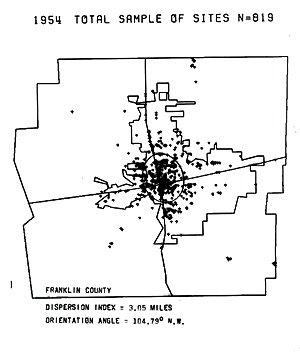Saving the World, One Parcel at a Time
 Since 1967, Dr. David J. Cowen—the current chair of the National Geospatial Advisory Committee (NGAC)—has focused his research and teaching interests on the development and implementation of GIS in a wide range of settings. A distinguished professor emeritus and former chair of the Department of Geography, University of South Carolina (USC), he established one of the first academic programs in GIS. Before chairing the Department of Geography, Cowen directed the College Computing Center and served as interim vice president for computing. The university became Esri customer number seven, one of the first to use Esri software. His management of the College of Liberal Arts computer center and teaching placed USC in a leadership position as computers and computer programming became ubiquitous in everyday business and academic life. When he was asked to be the permanent vice president for computing, his wife Sandy reminded him where his heart lies: "'You'd have to give up your GIS stuff,'" Cowen laughs as he remembers her words of advice that kept him on a path paved with accomplishments.
Since 1967, Dr. David J. Cowen—the current chair of the National Geospatial Advisory Committee (NGAC)—has focused his research and teaching interests on the development and implementation of GIS in a wide range of settings. A distinguished professor emeritus and former chair of the Department of Geography, University of South Carolina (USC), he established one of the first academic programs in GIS. Before chairing the Department of Geography, Cowen directed the College Computing Center and served as interim vice president for computing. The university became Esri customer number seven, one of the first to use Esri software. His management of the College of Liberal Arts computer center and teaching placed USC in a leadership position as computers and computer programming became ubiquitous in everyday business and academic life. When he was asked to be the permanent vice president for computing, his wife Sandy reminded him where his heart lies: "'You'd have to give up your GIS stuff,'" Cowen laughs as he remembers her words of advice that kept him on a path paved with accomplishments.

David J. Cowen
Throughout his career, Cowen has been involved in many projects ranging from decision support systems, economic development, and school performance to land-use changes and real estate. Even in retirement, Cowen continues in his advocacy of GIS, serving as the chair of the Department of the Interior's NGAC and as a member of the National Research Council (NRC) Board on Earth Sciences and Resources and as a national associate of the National Academy of Sciences, consulting with the US Census Bureau on its modernization program, as well as serving as an adviser to Pennsylvania State's Geospatial Revolution Project.
Seeing Areas Through the Lines
Cowen began his long and storied career receiving both bachelor and master of arts degrees in economic geography from the State University of New York at Buffalo. He went on to earn a PhD in geography from Ohio State University in 1971. His dissertation research in 1969 provided the impetus for his career in GIS. Motivated by the need for tools to map and analyze the movement of manufacturing firms, he wrote his own FORTRAN routines to calculate measurements and generate maps on pen plotters.
Afterward, Cowen moved to South Carolina, where he devoted time and energy to teaching students and evangelizing the use of GIS in the state. His vision helped promote the adoption of the technology throughout South Carolina. "Computer programmers would look at coastal maps and see just a bunch of boundaries," says Cowen. "I saw these not as lines but as areas that could be calculated, shaded, and analyzed." As a result, the State of South Carolina implemented one of the first Coastal Zone Management Plans with a complete inventory of existing land uses.
Cowen has influenced many people, as Tim De Troye, GISP, state GIS coordinator for South Carolina and president elect of the National States Geographic Information Council, explains: "I have known Dave Cowen for 16 years. My first exposure to him was as a master's student at USC, where I took an independent study course with him on GIS. When I decided to return to school to pursue my PhD, my one condition was to have Dave as my dissertation adviser. Our paths still cross, and I appreciate the valuable insight he provides. I'm continually amazed by the great number of people in the profession I run across who have been positively impacted either by working with him directly or by reading his work."
Doug Calvert, chairman of the South Carolina GIS Coordinating Council, agrees: "Dr. Cowen has been referred to by many as the 'father of GIS' in South Carolina. His influence will persist through the multitude of students he taught now working in GIS, as well as his tireless efforts promoting GIS solutions for state and national issues. He has been a longtime champion for GIS coordination here in South Carolina."
Land Parcels Represent the Critical Geographic Dimension
Cowen's impact and desire to apply GIS analysis earned him Esri's Lifetime Achievement Award in 2005. Afterward, Cowen devoted time chairing NRC's study National Land Parcel Data: A Vision for the Future. For the study, Cowen examined the status of land parcel data in the United States. He believes that land parcels represent the critical geographic dimension to analyze the use, value, and ownership of property. Cowen's interest in this subject is particularly important, as the public sector questions whether it is technically or economically feasible to integrate parcel data. Several private-sector firms, including insurance and real estate firm CoreLogic, have raced to complete just such a system. Today, businesses are finding that parcel data is critical to their business applications.
Under Cowen's direction, the committee of 12 experts from all levels of government and the private sector developed a vision and series of findings and recommendations. The committee envisioned a system employing modern, distributed database concepts and practices similar to those employed in many local governments or businesses. Conclusions from the study were that a nationally integrated land parcel database is necessary, feasible, and affordable.

Motivated by the need for tools to map and analyze the movement of manufacturing firms back in the early 1970s, Cowen wrote his own FORTRAN routines to calculate measurements and generate maps on pen plotters.
Opportunities Arise out of Crisis
Since the recent mortgage crisis in the United States, the need for federally mandated parcel data was again investigated, and Cowen served on the Cadastral Subcommittee Mortgage Study Team Steering Committee. The Federal Geographic Data Committee (FGDC) Cadastral Subcommittee met with the International Association of Assessing Officers in 2009 to explore the potential uses of land parcel data for more effective management of mortgage and financial oversight programs and activities.
The recommendations from the steering committee pointed again to a national parcel database and included the need to add local parcel ID numbers to Home Mortgage Disclosure Act data that would serve as a link to a wide range of attribute information. This information could be used in a parcel early warning system, much like that used at the Centers for Disease Control and Prevention to track early warning indicators for public health. This national system would detect early indicators of a financially distressed housing and mortgage market. As a result, the Dodd-Frank Wall Street Reform and Consumer Protection Act includes amendments to the 1975 Home Mortgage Disclosure Act. FGDC also made a national perspective on land parcels the focus of its 2009 Annual Report.
Think Globally, Act Locally
During his tenure at USC, Cowen directed 45 master's students and 11 PhD students, many of whom are now leaders in the academic and public- and private-sector GIS industry. "It is always great to have a teacher, mentor, and friend all wrapped into one person," says Anne Hale Miglarese, a principal with Booz Allen Hamilton and past chair of the National Geospatial Advisory Committee. "Through the years, Dave has always stayed on the edge of the technology, curious and energized by driving innovation. This intellectual curiosity has served us all well, and I, for one, continue to learn from him."
Even in retirement, Cowen continues to educate those around him in the capabilities of GIS. These days, he can be found at the USC Columbia campus evangelizing the use of GIS not for mapping parcels across the United States but focusing on the university itself. Through his guidance, facilities managers are looking at how GIS can create a comprehensive geospatial database that includes everything aboveground, on the ground, and underground.
"We saw the need to have emergency medical services, police, and our maintenance team know where everything is on campus, so campus safety and protection have driven our desire to map out all the utilities," says Don Gibson, assistant director of maintenance services. "We have all this talent in the university, and we have a world-class program in GIS studies. Fortunately for us, Dave Cowen is available to assist us on this project."
For more information, contact David Cowen (e-mail: cowend@sc.edu).